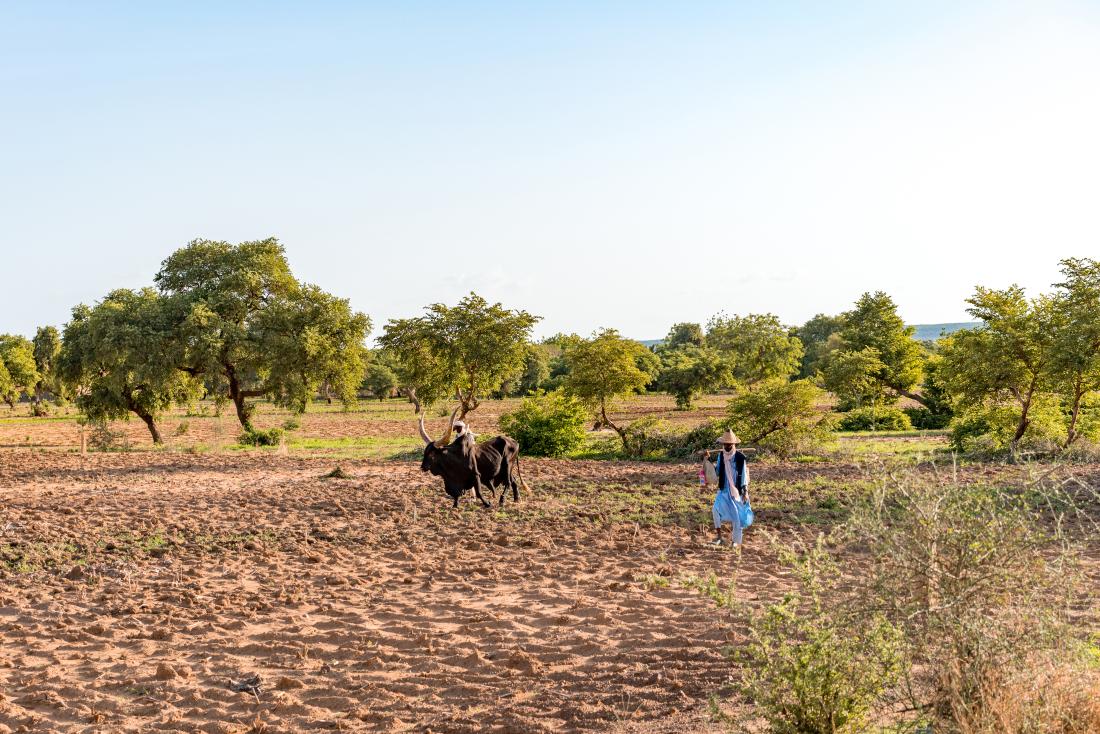The Impact of Farmer Managed Natural Regeneration and Formalized Land Rights on Reforestation and Crop Yields in Niger
- Farmers
- Rural population
- Families and households
- Deforestation
- Earnings and income
- Business investment
- Climate change mitigation
- Food security
- Productivity
- Profits/revenues
- Trust
- Extension services
- Natural resource management
- Sustainable farming
- Legal assistance
Reforesting farmland in Niger could simultaneously contribute to building farmers’ resilience to and mitigating climate change. Farmer Managed Natural Regeneration (FMNR) is an approach for natural reforestation that harnesses the tree seeds, roots, and trunks from past clear cutting to grow new trees. A potential barrier to take-up of FMNR is insecure land rights, as farmers may not be willing to adopt this long-term process on land where their access is insecure. Researchers are conducting a randomized evaluation to test the impact of FMNR and formalizing land rights on land tenure, reforestation of land, crop yields, soil fertility, and farmer well-being.
Policy issue
Trees are an important natural resource for people all over the world, providing food, medicine, and timber. Moreover, because they sequester carbon and protect biodiversity, they are vital for environmental well-being.1 Consequently, reducing deforestation and increasing reforestation can contribute to mitigating and building resilience to climate change.
Globally, one of deforestation’s main causes is increasing demand for agricultural land. Current evidence shows that formalizing farmers’ land rights can reduce deforestation. This may be partly because farmers with formalized land rights feel more secure in their land-holdings,2 increase long-term land investments,3 and thereby increase land productivity, reducing the need to expand to new, forested land.4
However, it is unclear whether formalizing land rights can increase reforestation, particularly through a technique called Farmer Managed Natural Regeneration (FMNR), in which tree seeds, roots, and trunks remaining in the soil after past clear cutting are fostered to grow new trees.5 There is observational evidence to suggest that FMNR increases reforestation and crop yields,6 but it has yet to be tested rigorously. Can access to land rights increase take-up of FMNR, and can FMNR increase crop yields and reforestation?
Context of the evaluation
In the 1980s, small-scale farmers in Maradi and Zinder, Niger, began practicing FMNR on their land. Some farmers adopted FMNR independently, to increase their crop yields, while others took up FMNR in response to incentives from international NGOs aiming to increase reforestation.7 Recently, FMNR has become an increasingly important tool for combatting desertification in Niger. Since 2017, the World Agroforestry Center (ICRAF) and World Vision have been implementing a program in Maradi and Zinder called “Regreening Africa,” in which they train farmers in the practice of FMNR, assist farmers in acquiring customary land certificates, and support villages in establishing rules to protect their forests. In 2020, to incentivize farmers to practice FMNR, Niger issued a decree protecting the rights of farmers to harvest resources from trees grown on their land.
In Niger, 42 percent of the population lives in extreme poverty and 90 percent live in rural areas. In Zinder and Maradi, agricultural activities constitute 33.5 and 45.6 percent of household income among people experiencing poverty. Farmers in Zinder and Maradi are exposed to climate shocks, such as irregular rainfall or high temperatures, that can impact their crop yields. Female farmers in Niger have limited land rights, potentially limiting their investment into agricultural land and adoption of FMNR.

Details of the intervention
In partnership with CIFOR-ICRAF and World Vision, researchers are conducting a randomized evaluation to test the impact of FMNR and formalizing land rights on land tenure, reforestation of land, crop yields, soil fertility, and farmer well-being over three years. Researchers randomly assigned approximately 3,000 farmers to one of three groups:
- FMNR training group (1,000 farmers): Farmers were offered training in the practice of FMNR.
- FMNR training and legal assistance group (1,000 farmers): Farmers were offered the same training in the practice of FMNR as well as legal assistance in acquiring customary land certificates for their agricultural land.
- Comparison group (1,000 farmers): Farmers were not offered any training or legal assistance.
Researchers are measuring the environmental, economic, and social impacts of FMNR and formalizing land rights. In particular, they will measure tree cover, biodiversity, carbon absorption, soil erosion, farming investment, crop yields and revenues, firewood gathering time use, frequency of land conflicts, trust in land governance institutions, and the frequency of land being used as collateral for loans. ICRAF is applying their Land Degradation Surveillance Framework, using a custom app, to measure environmental outcomes digitally, and AidData is measuring additional environmental outcomes using satellite data. Researchers are collecting data once before the intervention and again three years later.
Results and policy lessons
Research ongoing; results forthcoming.
CIFOR-ICRAF. 2023. “The urgent need to conserve and use trees.” https://www.worldagroforestry.org/publication/urgent-need-conserve-and-use-trees
Wren-Lewis, Liam, Luis Becerra-Valbuena, and Kenneth Houngbedji. 2020. “Formalizing Land Rights Can Reduce Forest Loss: Experimental Evidence from Benin.” Science Advances 6 (26), https://doi.org/10.1126/sciadv.abb6914.
Goldstein, Markus, Kenneth Houngbedji, Florence Kondylis, Michael O’Sullivan, and Harris Selod. 2018. “Formalization without Certification? Experimental Evidence on Property Rights and Investment.” Journal of Development Economics 132 (May): 57–74. https://doi.org/10.1016/j.jdeveco.2017.12.008.
Wren-Lewis, Liam, Luis Becerra-Valbuena, and Kenneth Houngbedji. 2020. “Formalizing Land Rights Can Reduce Forest Loss: Experimental Evidence from Benin.” Science Advances 6 (26), https://doi.org/10.1126/sciadv.abb6914.
Chris Reij and Dennis Garrity. 2016. “Scaling up farmer-managed natural regeneration in Africa to restore degraded landscapes.” Biotropica, 48 (6), https://onlinelibrary.wiley.com/doi/full/10.1111/btp.12390.
Reij, Chris, Gray Tappan, and Melinda Smale. 2009. “Agroenvironmental Transformation in the Sahel: Another Kind of ‘Green Revolution.’” IFPRI Discussion Paper.
Chris Reij and Dennis Garrity. 2016. “Scaling up farmer-managed natural regeneration in Africa to restore degraded landscapes.” Biotropica, 48 (6), https://onlinelibrary.wiley.com/doi/full/10.1111/btp.12390.




